The Millrose Games is an annual indoor athletics meet held each February in New York City. They started taking place at the Armory in Washington Heights in 2012, after having taken place in Madison Square Garden from 1914 to 2011. The games were started when employees of the New York City branch of Wanamaker's department store formed the Millrose Track Club to hold a meet. The featured event is the Wanamaker Mile.

Newtown High School is a high school in Elmhurst, a neighborhood in the New York City borough of Queens. It occupies an entire city block bound by 48th and 50th Avenues, and 90th and 91st Streets. Its student body consists of approximately 1,878 students.
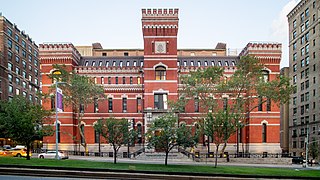
The Seventh Regiment Armory, also known as Park Avenue Armory, is a historic National Guard armory building located at 643 Park Avenue in the Upper East Side neighborhood of Manhattan, New York City. The building is a brick and stone structure built in 1880 and designed in the Gothic Revival style by Charles Clinton.

The 69th Regiment Armory is a historic National Guard armory building located at 68 Lexington Avenue between East 25th and 26th Streets in the Rose Hill section of Manhattan, New York City. The building began construction in 1904 and was completed in 1906. The armory was designed by the firm of Hunt & Hunt, and was the first armory built in New York City to not be modeled on a medieval fortress; instead, it was designed in the Beaux-Arts style.

3 Park Avenue is a mixed-use office building and high school located on Park Avenue in Manhattan, New York City that was built in 1973. The building, surrounded on three sides by a plaza, is categorized as a Midtown South address in the Kips Bay, Manhattan, Murray Hill, and Rose Hill neighborhoods. It is located between East 33rd and 34th Streets, close to the 33rd Street subway station, an entrance to which is built into the building.
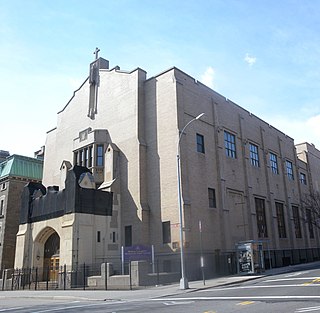
Bishop Loughlin Memorial High School is a private, Roman Catholic, co-educational, college-preparatory high school located at 357 Clermont Avenue in the Ft. Greene neighborhood of Brooklyn, New York. The school serves students in grades 9 through 12. Loughlin was founded in 1851 and was the first high school in the Diocese of Brooklyn (1853), but today is run independently by the Christian Brothers in the Lasallian educational tradition.
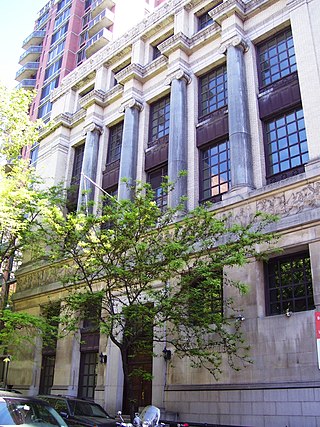
The New York School of Applied Design for Women, established in 1892 by Ellen Dunlap Hopkins, was an early design school for women in New York City. The 1908 New York School of Applied Design building was designed by Harvey Wiley Corbett and is now landmarked.
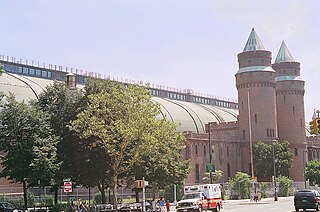
The Kingsbridge Armory, also known as the Eighth Regiment Armory, is a decommissioned armory at Jerome Avenue and West Kingsbridge Road in the Kingsbridge Heights neighborhood of the Bronx in New York City. It was built in the 1910s, from a design by the firm of then-state architect Lewis Pilcher to house the New York National Guard's Eighth Coast Defense Command, a regiment-sized unit which relocated from Manhattan in 1917. It is possibly the largest armory in the world.
The IAAF Indoor Permit Meetings were an annual series of indoor track and field competitions organized by the International Association of Athletics Federations (IAAF) from 1997 until the end of 2015 season. In 2016 IAAF launched the IAAF World Indoor Tour including four meetings which have all regularly held an IAAF Indoor Permit.

The 369th Regiment Armory is a historic National Guard Armory building located at 2366 Fifth Avenue, between West 142nd and 143rd Streets, in Harlem, Manhattan, New York City. It was built for the 369th Regiment, also known as the "Harlem Hell Fighters", founded in 1913 as the first National Guard unit in New York State composed solely of African-Americans. It later became home to the 369th Sustainment Brigade.

The New Scotland Avenue Armory is located on New Scotland Avenue in Albany, New York, United States. It is a large brick building constructed in the early 20th century. In 1994 it was listed on the National Register of Historic Places, one of two armories in the city of Albany to be so designated.

The former Yonkers Trolley Barn is located on Main Street in Yonkers, New York, United States. It is a massive steel frame brick building in the Renaissance Revival style built at the beginning of the 20th century. In 2002 it was listed on the National Register of Historic Places as the last remaining trolley barn in Westchester County and the only remnant of Yonkers' trolley system.

The 23rd Regiment Armory, also known as the Bedford Atlantic Armory, is a historic National Guard armory building located at 1322 Bedford Avenue between Atlantic Avenue and Pacific Street in the Crown Heights neighborhood of Brooklyn, New York City, United States. The building is a brick and stone castle-like structure designed to be reminiscent of medieval military structures in Europe. It was built in 1891–95 and was designed in the Romanesque Revival style by Fowler & Hough, local Brooklyn architects, and Isaac Perry, the New York state government's architect.
The Armory Foundation is a non-profit organization located in New York City that operates the historic Fort Washington Avenue Armory. The Armory hosts over 100 track meets and over 220,000 athlete visits each year, including the prestigious Millrose Games. The Armory is home to more track & field records than any other facility in the world.
U.S. Open Track and Field was the name of the first top level indoor track and field meet in 2012. The U.S. Open was the opening competition in the 2012 IAAF Indoor Permit Meeting series and was also part of the Visa Championship Series. Held in Madison Square Garden in New York City, the inaugural event was announced for January 28, 2012, with television coverage on January 29 at 7 p.m. Eastern Time on ESPN2.

Charles Alling Gifford was an American architect and a partner in the New York City firm of Gifford & Bates. He is best remembered for his resort hotels, but also designed houses, churches, and five armories for the New Jersey National Guard.
Norbert Sander was an American physician and runner who won the New York City Marathon in 1974. He has been described as "one of the most influential track and field figures in the city's history."
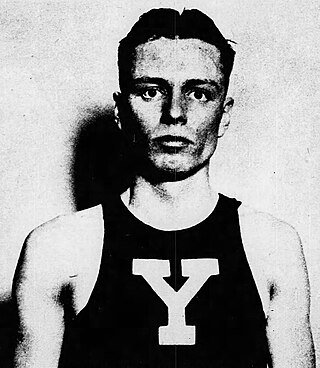
John Williams Overton, also known as Johnny Overton, was an American middle-distance runner and soldier who was killed in action in World War I. He was a national champion track and cross country runner at Yale University and joined the United States Marine Corps after his graduation in 1917. In track, he set the world records for the indoor mile run and indoor 1,000-yard distance in 1917. He was also the college cross country champion in 1915 and 1916.
The New Balance Games was an annual indoor track and field meet which was held in late January at the Fort Washington Avenue Armory. It was first held in Manhattan, a neighbourhood in New York City.





















